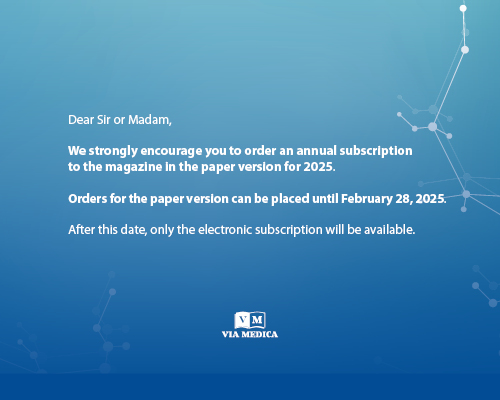Atrial fibrillation (AF) prevalence in the adult population is estimated between 2% and 4%. AF increases the risk of stroke approximately 5-fold. To prevent stroke, we use anticoagulant therapy, which is recommended in patients with a CHA2DS2-VASc score of ≥2 in men or ≥3 in women and should be considered in patients with a CHA2DS2-VASc score of 1 in men or 2 in women. In patients with contraindications to chronic anticoagulant therapy, an alternative is percutaneous left atrial appendage closure (LAAC) [1, 2].
We present a description of the left atrial appendage closure procedure in a patient with contraindications for long-term anticoagulant treatment due to congenital hemophilia C.
A 72-year-old man with hemophilia C (a hereditary bleeding disorder characterized by factor XI deficiency) and permanent atrial fibrillation (AF), without any kind of antithrombotic therapy, was referred to our center by his cardiologist. His medical history included hypertension, ventricular arrhythmia, prostate cancer treated by prostatectomy 6 years earlier, and post-traumatic subdural hematoma 16 years earlier.
The CHA2DS2-VASc score was estimated at 2, and his HAS-BLED score was 3. After evaluation, his case was presented at the Heart Team consultation, and the patient was qualified for LAAC.
Transesophageal echocardiography (TEE) revealed a thrombus of 0.8 cm diameter (Figure 1A) in the left atrial appendage (LAA). Laboratory tests showed an increase in activated partial thromboplastin time (APTT) at 82.9 sec with a normal international normalized ratio (INR) — 1.4. The LAAC procedure was postponed. The patient was consulted by a hematologist, who disqualified him from any kind of antithrombotic treatment. The patient was discharged from the hospital, and the next evaluation was scheduled after 2 months to check the presence of the thrombus.
After 2 months, TEE was performed, which showed a presence of spontaneous contrast in the left atrial appendage, which on the bottom had gelatinous consistency and was on the verge of clotting (Figure 1B). The APTT was also increased this time, and the INR level was normal. Factor XI level was evaluated at 1.4%. It was decided to perform the procedure shortly without contrast injection for device positioning in the left appendage (navigating with TEE only).
After 7 days, we admitted the patient again. This time during TEE, no thrombus was found in LAA (Figure 1C). Only a presence of spontaneous contrast was noticed, which was not a contraindication to the LAAC procedure. It was decided to perform the procedure. Due to heritage factor XI deficiency, the patient had a consultation with a hematologist who recommended 6 units of fresh frozen plasma (FFP) within 12 hours before the planned procedure. After transfusion, factor XI level was 23.6% and APTT was 37.1 seconds, and 2 more units of FFP were transfused in the operating room just before the procedure. After that preparation, the patient underwent successful percutaneous left atrial appendage closure using a 35mm Watchman FLX device (Figure 1D–F). The procedure went without complications. In the postoperative period, further 2 units of FFP were transfused. On the first day after LAAC, the level of factor XI was 28.9%, and APTT was 26.3 seconds. No hemorrhagic complications during further hospitalization occurred. On the 4th day after LAAC, TEE confirmed the correct position of the closure device. The same day, the patient was discharged from the hospital in stable condition.
To our knowledge, it is the first reported case of percutaneous left atrial appendage closure in a patient with hemophilia C. We found only 17 described cases of LAAC in patients with hemophilia (15 hemophilia A, 2 hemophilia B), none in Poland [3–5]. In our opinion, after appropriate preparation, LAAC is a safe strategy in patients with hemophilia C and AF.
Article information
Conflict of interest: None declared.
Funding: None.
Open access: This article is available in open access under Creative Common Attribution-Non-Commercial-No Derivatives 4.0 International (CC BY-NC-ND 4.0) license, which allows downloading and sharing articles with others as long as they credit the authors and the publisher, but without permission to change them in any way or use them commercially. For commercial use, please contact the journal office at kardiologiapolska@ptkardio.pl.



